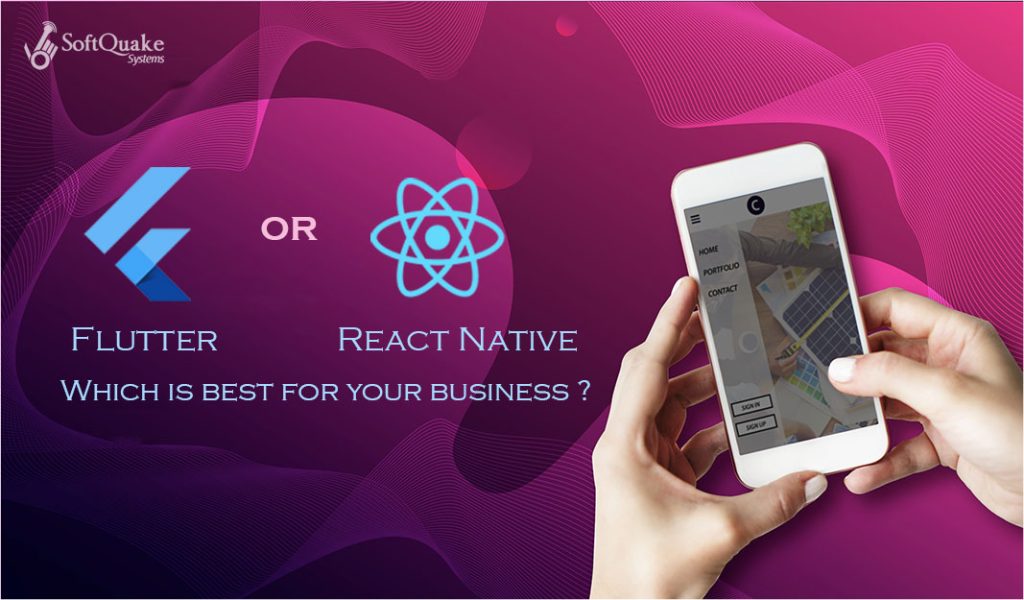
Mobile applications have become integral to modern life, facilitating communication, entertainment, shopping, and business operations. They offer convenience, enhance productivity, and provide a platform for innovative solutions across various industries. Mobile apps enable businesses to engage with customers more effectively, streamline processes, and offer personalized experiences, driving growth and customer satisfaction.
Introduction: Flutter vs React Native
Flutter and React Native are two of the most popular frameworks for building cross-platform mobile applications. They enable developers to write code once and run it on both Android and iOS platforms, reducing development time and cost. Despite their common goal, Flutter and React Native have distinct characteristics, architectures, and ecosystems, which can influence the choice of framework depending on the project requirements.
History of Flutter and React Native
Flutter
- Developed by: Google
- Initial Release: May 2017
- Language Used: Dart
- Overview: Flutter is an open-source UI software development kit (SDK) created by Google. It allows developers to build natively compiled applications for mobile, web, and desktop from a single codebase. Flutter emphasizes high performance and a rich set of pre-designed widgets that adhere to Material Design guidelines.
React Native
- Developed by: Facebook
- Initial Release: March 2015
- Language Used: JavaScript (and React)
- Overview: React Native is an open-source mobile application framework developed by Facebook. It enables developers to use React along with native platform capabilities. React Native bridges JavaScript and native code, making it possible to write parts of the application in JavaScript and the rest in native code, providing flexibility and performance.
Market Overview
Market Share and Adoption:
- Flutter has seen rapid growth due to strong support from Google and a growing community. Popular among startups and enterprises looking for high-performance apps with a custom UI.
- React Native has a large and mature ecosystem with many third-party libraries. Favored by companies already using JavaScript for web development, such as Facebook, Instagram, and Airbnb.
Flutter vs. React Native – Crucial Points to Consider
Performance
- Flutter: Flutter apps are known for their high performance due to direct compilation to native ARM code, which eliminates the JavaScript bridge. The rich set of widgets also contributes to smooth animations and interactions.
- React Native: React Native uses a bridge between JavaScript and native components, which can introduce performance bottlenecks, especially for complex animations and interactions. However, optimizations and improvements have been continuously made.
Development Experience
- Flutter: Flutter offers a fast development cycle with its “hot reload” feature, which allows developers to see changes instantly without losing the state of the application. The Dart language is also relatively easy to learn for those familiar with JavaScript or C-style languages.
- React Native: React Native also supports hot reloading, making it efficient for development. Since it uses JavaScript, which is widely known and used, the learning curve can be less steep for many developers. React Native’s extensive community and the availability of numerous libraries and tools further enhance the development experience.
Ecosystem and Libraries
- Flutter: Flutter’s ecosystem is growing rapidly, with an increasing number of plugins and packages available through the Flutter Package Manager. However, it still lags behind React Native in terms of the sheer number of available libraries.
- React Native: React Native has a mature and extensive ecosystem, with a wide variety of third-party libraries and components. The support from the JavaScript community adds to the richness of resources available for developers.
UI and Customization
- Flutter: Flutter’s widget-based architecture allows for extensive customization and flexibility in designing UI. Its widgets are highly customizable and can mimic the design of both iOS and Android applications.
- React Native: React Native provides a set of basic components that map directly to the platform’s native UI building blocks. For more complex UI, developers might need to rely on third-party libraries or write custom native modules.
Popularity and Community Support
- React Native: Boasts a larger community and more third-party libraries due to its longer presence in the market. Strong support from Facebook ensures continuous updates and improvements.
- Flutter: Rapidly growing community and backed by Google. Increasing number of plugins and tools are being developed by both the community and Google.
Pros and Cons of Flutter and React Native Apps
Flutter
Pros:
- High performance due to native ARM code compilation.
- Rich set of customizable widgets.
- Consistent look and feel across platforms.
- Strong support from Google and a growing community.
Cons:
- Relatively newer, so some libraries and tools may be less mature.
- Larger app size compared to native apps.
- Learning Dart might be a barrier for some developers.
React Native
Pros:
- Uses JavaScript, a widely-known language.
- Extensive ecosystem with numerous libraries and community support.
- Ability to integrate with native code easily.
- Mature framework with robust tooling and debugging capabilities.
Cons:
- Potential performance issues due to the JavaScript bridge.
- UI might not be as consistent across different platforms.
- Some third-party libraries may not be actively maintained.
Future of Flutter and React Native
The future of both Flutter and React Native looks promising as they continue to evolve and improve. Flutter is rapidly gaining popularity, driven by Google’s backing and its strong performance characteristics. Its ability to target multiple platforms (mobile, web, and desktop) from a single codebase makes it a compelling choice for many developers.
React Native remains a dominant force in the cross-platform development space due to its mature ecosystem and widespread use in the industry. Facebook and the community continue to invest in improving its performance and capabilities, ensuring it remains a viable option for many use cases.
Conclusion
Choosing between Flutter and React Native depends on the specific needs of your project, the expertise of your development team, and the long-term goals for your application. Flutter offers high performance, a rich set of widgets, and a growing ecosystem, making it an excellent choice for highly customized UIs and applications targeting multiple platforms. React Native, with its mature ecosystem, extensive library support, and use of JavaScript, remains a strong contender, especially for projects requiring integration with existing JavaScript codebases or those that benefit from its large community support.


 +91 8420731759
+91 8420731759












